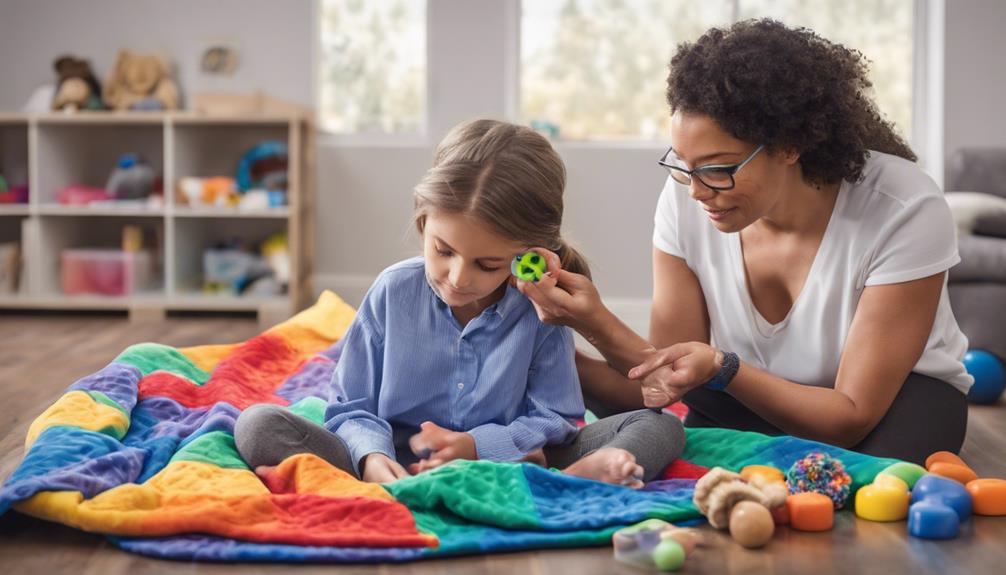Comparing speech therapy to occupational therapy is like comparing a conductor directing a symphony to a choreographer designing a dance; both are crucial but have distinct roles.
The nuances lie in how each therapy type addresses unique aspects of human development and function. As we unravel the layers of these therapeutic modalities, we begin to appreciate the intricate ways in which they cater to diverse needs and goals.
Let's delve deeper into this intriguing dichotomy to understand the specialized interventions each offers for individuals striving towards enhanced quality of life and well-being.
Key Takeaways
- Speech therapy focuses on communication and swallowing disorders, while occupational therapy aids in regaining everyday skills.
- Speech therapy targets speech impairments and language disorders, while occupational therapy targets fine motor and cognitive skills.
- Speech therapists work on articulation problems and voice disorders, while occupational therapists focus on enhancing functional independence.
- Speech therapists diagnose and treat communication challenges, while occupational therapists assist in daily tasks and motor skills.
Speech Therapy Overview
In speech therapy, we, as speech-language pathologists, diagnose, treat, and prevent communication and swallowing disorders to enhance our patients' quality of life. Our primary focus is on improving communication abilities, which can include speech impairments, language disorders, voice issues, and swallowing difficulties. By working closely with individuals facing these challenges, we aim to help them communicate effectively and comfortably in their daily lives.
Approximately 40% of speech therapists work in educational settings, while others can be found in private practices, hospitals, and care facilities. Regardless of the setting, our goal remains the same: to empower our patients to communicate better and improve their overall quality of life. Through tailored treatment plans, we address each individual's specific needs, whether it's helping a child with language development or assisting an adult in recovering speech after a stroke. Our dedication to enhancing communication skills is driven by the belief that effective communication is essential for personal growth and meaningful connections.
Occupational Therapy Overview

Transitioning from the realm of speech therapy, occupational therapy involves utilizing therapeutic techniques to assist individuals in regaining skills necessary for their everyday activities. Occupational therapists play a crucial role in helping patients overcome challenges due to injuries, illnesses, or disabilities. They work in diverse settings such as hospitals, schools, home healthcare services, or nursing care facilities, tailoring their interventions to meet the specific needs of each patient.
Here are three key aspects of occupational therapy:
- Holistic Approach: Occupational therapists take a holistic approach to treatment, considering the physical, emotional, and environmental factors that may impact a patient's ability to perform daily tasks. By addressing these various aspects, therapists can help patients achieve greater independence and quality of life.
- Adaptive Equipment: Therapists may recommend and provide adaptive equipment to assist patients in completing tasks. These tools can range from modified utensils for eating to specialized computer software for work-related activities, enabling patients to engage in activities that are important to them.
- Patient-Centered Care: Occupational therapy focuses on patient-centered care, where therapists work closely with individuals to set personalized goals and develop treatment plans that align with their specific needs and aspirations. This approach empowers patients to take an active role in their rehabilitation journey and enhances the overall effectiveness of therapy sessions.
Targeted Conditions in Speech Therapy
When it comes to speech therapy, we focus on specific conditions such as speech sounds therapy, fluency techniques used, and language development strategies.
It's essential to target articulation problems, fluency disorders, voice disorders, and language impairments to improve communication skills effectively. By addressing these areas, individuals can work towards clearer speech and better language comprehension.
Speech Sounds Therapy
Enhancing speech intelligibility and communication skills, Speech Sounds Therapy in speech therapy specifically targets conditions such as articulation disorders, phonological disorders, and apraxia of speech.
Here are three key aspects of Speech Sounds Therapy:
- Specific Sound Production: This therapy focuses on improving the ability to produce individual speech sounds correctly, which is crucial for clear and effective communication.
- Techniques Utilized: Therapeutic techniques may include auditory discrimination training to distinguish between sounds, oral-motor exercises to strengthen speech muscles, and phonetic placement cues to guide sound production.
- Overall Goal: The ultimate aim of Speech Sounds Therapy is to enhance speech clarity and overall communication skills for individuals with speech sound disorders, empowering them to communicate effectively and confidently.
Fluency Techniques Used
As we shift our focus to fluency techniques used in speech therapy, it's essential to understand how these methods target conditions such as stuttering, cluttering, and other fluency disorders. Fluency techniques aim to improve communication skills by addressing underlying factors contributing to speech disruptions.
Therapists may employ strategies like slow speech, easy onset, and gentle voicing to enhance fluency. Additionally, techniques such as pausing before speaking, utilizing breathing exercises, and adjusting speech rates are commonly utilized in therapy sessions.
Language Development Strategies
In speech therapy, we tailor language development strategies to address specific conditions such as articulation problems, fluency disorders, and expressive/receptive language issues.
Language Development Strategies in Speech Therapy:
- Individualized Approach: We design personalized activities using play, books, pictures, and interactive tools to suit each individual's needs.
- Child-Centered Techniques: For children, we focus on enhancing communication skills, vocabulary, grammar, and social interactions through age-appropriate strategies.
- Overall Improvement: Our language development strategies target language delays, disorders, and difficulties in expressing thoughts effectively, aiming to enhance communication abilities and promote clearer speech for better interaction and comprehension.
Targeted Conditions in Occupational Therapy

In occupational therapy, we address a wide range of conditions that affect motor skills, coordination, and daily living independence. Our focus is on enhancing hand-eye coordination, fine motor skills, and sensory processing abilities to help individuals thrive in their everyday activities.
From developmental delays in children to medical conditions like hand injuries or cancer, occupational therapy interventions are tailored to improve quality of life and functional abilities.
Occupational Therapy Scope
Occupational therapy targets a range of conditions such as autism, cerebral palsy, and Down syndrome, addressing developmental delays, sensory processing disorders, and physical disabilities. In our practice, we help individuals with fine motor skills, handwriting difficulties, and sensory integration challenges. The scope of occupational therapy also includes assisting people with daily living activities, work-related tasks, and school performance. Our goal is to support a wide range of populations, from children with learning disabilities to seniors facing age-related limitations.
- Occupational therapists focus on improving fine motor skills to enhance independence in activities of daily living.
- They work on addressing handwriting difficulties to facilitate effective communication and participation in various tasks.
- Occupational therapy aims to support individuals in sensory integration challenges to improve their quality of life and engagement in meaningful activities.
Occupational Therapy Techniques
Addressing a wide range of conditions such as sensory processing disorders, fine motor skill deficits, and developmental delays, occupational therapy techniques aim to enhance individuals' functional independence and engagement in daily activities.
These techniques may involve activities targeting fine motor skills to improve hand-eye coordination and dexterity. Additionally, occupational therapists focus on enhancing cognitive abilities through specialized exercises and tasks.
For individuals with sensory processing disorders, techniques are employed to help regulate sensory input and improve processing skills.
By incorporating a holistic approach that considers the individual's specific needs, occupational therapy techniques work towards fostering independence and improving overall quality of life.
Therapists utilize specialized tools and equipment to facilitate progress and help individuals achieve their goals.
Techniques Used in Speech Therapy

Utilizing age-appropriate methods such as play, books, and pictures, speech therapy aims to enhance communication and language skills through various techniques.
Here are three key techniques commonly used in speech therapy:
- Articulation Therapy: This technique focuses on correcting articulation problems like lisps or difficulty pronouncing certain sounds. Speech therapists work with individuals to improve the clarity of their speech by practicing specific sounds in isolation, syllables, words, phrases, and sentences.
- Fluency Therapy: For individuals experiencing fluency disorders such as stuttering, fluency therapy techniques help improve the flow of speech. Therapists may use strategies like breathing exercises, slowing down speech rate, and desensitization to reduce stuttering occurrences and promote smoother communication.
- Language Intervention: Speech therapy addresses receptive and expressive language disorders by targeting vocabulary, grammar, comprehension, and social communication skills. Through activities like storytelling, role-playing, and structured language exercises, therapists help individuals develop stronger communication skills to express their thoughts and understand others effectively.
Techniques Used in Occupational Therapy

To assist individuals in enhancing their motor skills and functional abilities, occupational therapy employs a variety of techniques such as therapeutic activities, exercises, and adaptive equipment. These techniques are designed to target specific areas like balance, coordination, fine motor skills, and sensory processing, all crucial for performing daily tasks with ease. Occupational therapists may also incorporate sensory integration methods, cognitive-behavioral strategies, and environmental adjustments to help patients achieve independence in their activities.
The primary goal of these techniques is to promote engagement in meaningful tasks, improve overall quality of life, and boost well-being. By tailoring the techniques to each individual's unique needs, goals, and challenges, occupational therapy maximizes the potential for independence and active participation in daily life. This personalized approach ensures that patients receive the support necessary to overcome obstacles and thrive in various aspects of their lives.
Key Differences in Therapeutic Approaches

In differentiating speech therapy from occupational therapy, we observe distinct therapeutic approaches tailored to specific aspects of individuals' needs and abilities. When comparing the therapeutic approaches of Occupational Therapy and Speech Therapy, it's crucial to understand the unique strategies each discipline employs to address different aspects of an individual's well-being:
- Occupational Therapy:
Occupational therapists focus on enhancing individuals' ability to perform daily tasks and improve motor skills, balance, and coordination. They achieve this by using everyday activities as therapeutic tools, helping individuals regain independence and autonomy in their daily lives.
- Speech Therapy:
Speech therapists concentrate on improving communication, language, and speech-related challenges. They address issues such as articulation, fluency, voice, and language disorders by utilizing techniques like play, books, and pictures to engage clients actively in the therapeutic process.
- Tailored Approach:
While occupational therapy targets disabilities, illnesses, or injuries affecting daily living activities, speech therapy is specifically designed for communication and swallowing disorders. Each therapy type provides specialized interventions to meet the unique needs of individuals seeking assistance in different areas of their lives.
Educational Requirements for Therapists

When pursuing a career in speech therapy or occupational therapy, individuals must fulfill specific educational requirements to become licensed practitioners. Speech-language pathologists need a master's degree in speech-language pathology, focusing on communication disorders and therapy techniques.
On the other hand, occupational therapists require a master's or doctoral degree in occupational therapy, which covers topics like anatomy, physiology, and therapeutic interventions. Both fields involve clinical practicum experiences as part of their educational requirements, providing hands-on training essential for working with patients effectively.
These educational programs equip future therapists with the knowledge and skills needed to assess, diagnose, and treat individuals with speech or occupational challenges. By meeting these educational standards, aspiring therapists demonstrate their commitment to providing high-quality care and making a positive impact on their patients' lives.
Aspiring therapists should be prepared to dedicate time and effort to their education to meet the rigorous demands of these rewarding professions.
Salary and Job Outlook Comparison

As we shift our focus to the comparison of salary and job outlook between speech-language pathologists and occupational therapists, it's essential to understand the financial and professional landscape of these two distinct yet vital therapy professions. When considering a career path in therapy, here are three key points to keep in mind:
- Salary Differences: Speech-language pathologists have a median annual salary of approximately $79,060, while occupational therapists earn around $85,570 annually. This variation in earnings reflects the different demands and responsibilities of each profession.
- Job Outlook Disparities: The job outlook for speech-language pathologists is notably more optimistic, with a projected growth rate of 21% from 2021 to 2031. In comparison, occupational therapy is expected to experience a 14% growth during the same period. This forecast indicates a higher demand for speech-language pathologists in the coming years.
- Professional Growth: With a higher job growth rate and a rewarding median salary, pursuing a career as a speech-language pathologist can offer both financial stability and professional fulfillment. The increasing demand for speech therapy services underscores the importance of this profession in healthcare.
Frequently Asked Questions
What Is the Difference Between Speech Feeding and Ot?
When we look at the difference between speech feeding therapy and OT, it's essential to note that speech feeding therapy focuses on improving swallowing and feeding difficulties, while OT addresses daily living skills.
Speech feeding therapy targets oral motor function, aiding in chewing, swallowing, and feeding coordination.
On the other hand, OT helps with adaptive strategies for feeding and overall daily tasks.
Both therapies are vital in enhancing individuals' functional abilities for daily living.
Can OT Help With Speech Therapy?
Yes, occupational therapy can assist with speech therapy. OTs like us often incorporate speech techniques into our sessions to help improve communication skills.
While we focus on daily living activities, we can support speech development too. Collaborating with speech-language pathologists, we enhance speech outcomes for many patients.
Though not speech therapy specialists, we play a valuable role in addressing speech concerns and aiding in communication skill improvement.
What Is the Difference Between SLP and OT Cognition?
When it comes to cognition, Speech-Language Pathologists (SLPs) focus on areas like memory, attention, and problem-solving skills, while Occupational Therapists (OTs) work on cognitive abilities related to daily tasks and routines.
SLPs help with language and communication aspects of cognition, while OTs assist with cognitive skills that impact physical and mental functioning in daily life.
Both professions collaborate to address diverse cognitive needs, offering comprehensive support for individuals' cognitive development and independence.
What Do OT PT and SLP Have in Common?
In our field, OT, PT, and SLP share the common goal of enhancing individuals' well-being through therapy interventions. We collaborate to provide holistic care and help people of all ages overcome challenges and regain independence.
Our specialized education and licensure enable us to make a positive impact on patients' lives. As a team, we play crucial roles in improving quality of life and promoting overall health and wellness.
Conclusion
In conclusion, speech therapy and occupational therapy both play crucial roles in improving the lives of individuals with communication and physical challenges.
While speech therapy focuses on enhancing language and communication skills, occupational therapy targets motor skills and daily functioning.
Together, these therapies offer a holistic approach to overall well-being, like a symphony harmonizing different notes to create a beautiful melody of progress and empowerment.











